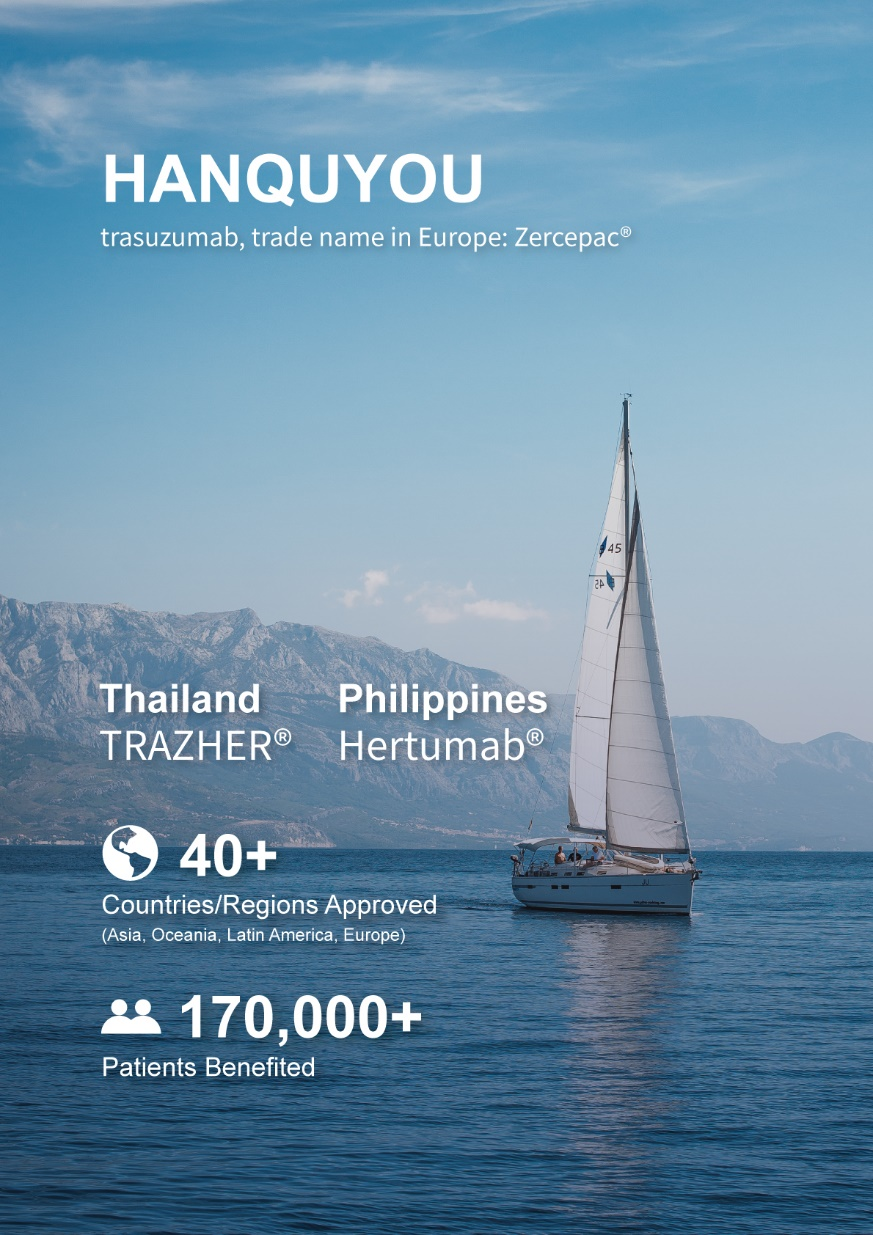Henlius’ Trastuzumab Plots Southeast Asia Expansion, to Enter Thailand and Philippines
Recently, Henlius' self-developed and manufactured HANQUYOU (trastuzumab, trade names: Zercepac® in Europe, Tuzucip® and Trastucip® in Australia) has been approved for marketing in Thailand and the Philippines under the trade names of TRAZHER® and Hertumab®, respectively, for the treatment of HER2-positive breast cancer and gastric cancer. Up to now, HANQUYOU has been successfully approved in Southeast Asian countries, including Singapore and Cambodia, and in a total of more than 40 countries and regions.

Breast cancer is the most prevalent malignancy in Southeast Asia, with nearly 170,000 new cases of breast cancer in the region in 2022 [1]. About 15% to 20% of breast tumours are HER2-positive breast cancers. [2]. On the other hand, the reported rates of HER2 positivity in patients with gastric cancer range from 12% to 23% [3]. Trastuzumab has long been a cornerstone of therapy for the treatment of HER2-positive breast and gastric cancers, and has been included as a first-line treatment option in the National Comprehensive Cancer Network (NCCN) guidelines, the Chinese Society of Clinical Oncology (CSCO) guidelines, and the European Society of Medical Oncology (ESMO) guidelines -6. Currently, Henlius is working with KGbio in most Southeast Asia to promote the commercialisation of HANQUYOU in the regional market, to provide more efficient and safe treatment options for local patients, to boost regional healthcare, and to enhance the accessibility of high-quality biologics in emerging markets.
Henlius independently developed HANQUYOU in accordance with the National Medical Products Administration (NMPA), the European Medicines Agency (EMA), the U.S. Food and Drug Administration (FDA) and other international biosimilar guidelines. It was approved for commercialisation by the European Commission (EC) and NMPA in July 2020 and August 2020, respectively. It is the first China-developed mAb approved both in China and Europe and is expected to be the first China-developed biosimilar approved in China, Europe, and the United States (U.S) with the U.S. FDA’s acceptance of the BLA filing which is expected to be approved in 2024. Since its approval, HANQUYOU has been successfully approved in more than 40 countries and regions, including the United Kingdom, France, Germany, Switzerland, Australia, Finland, Spain, Argentina, Saudi Arabia, Singapore, etc., covering Asia, Oceania, Latin America, and Europe, and it is reimbursed nationally in countries and regions including China, the United Kingdom (UK), France and Germany. To date, HANQUYOU has benefited more than 170,000 patients.
The manufacturing facilities for HANQUYOU and the quality management system are in line with global standards. Among them, the Xuhui Facility has obtained Good Manufacturing Practice (GMP) certifications from China and the EU. Also, the facility has successfully passed the on-site inspections and audits conducted by the NMPA, the EMA, the EU qualified person, and multiple international business partners and received the Pre-licencing Inspection (PLI) conducted by the U.S. FDA in 2023. A total commercial capacity of 48,000 Liters allows the company to supply products stably to markets beyond China, including Europe, Southeast Asia and Latin America. The company’s total capacity is expected to hit 144,000 Liters in 2026 to address the ever-increasing global market needs.
Henlius has aggressively pursued international commercialisation of HANQUYOU, actively collaborating with global partners such as Accord Healthcare, Abbott, Eurofarma, Elea and KGbio to bring its therapeutics to patients in the U.S., Europe, and other emerging markets, covering about 100 countries and regions. In the future, Henlius will continue to promote the approval and launch of HANQUYOU in more countries and regions to accelerate the delivery of high-quality, affordable, and innovative medicines to patients worldwide.
【参考文献】
[1] Ferlay J, Ervik M, Lam F, Laversanne M, Colombet M, Mery L, Piñeros M, Znaor A, Soerjomataram I, Bray F (2020). Global Cancer Observatory: Cancer Today. Lyon, France: International Agency for Research on Cancer. Available from: https://gco.iarc.who.int/today, accessed [29 January 2024]
[2] American Cancer Society. Cancer Facts and Figures 2024. Atlanta: American Cancer Society; 2024.
[3] NCCN Clinical Practice Guidelines in Oncology (NCCN Guidelines®) for Gastric Cancer V.3.2023
[4] NCCN Clinical Practice Guidelines in Oncology (NCCN Guidelines®) for Breast Cancer V.1.2024
[5] Loibl S, André F, Bachelot T, et al. Early breast cancer: ESMO Clinical Practice Guideline for diagnosis, treatment and follow-up. Ann Oncol. 2024;35(2):159-182. doi:10.1016/j.annonc.2023.11.016
[6] Gennari A, André F, Barrios CH, et al. ESMO Clinical Practice Guideline for the diagnosis, staging and treatment of patients with metastatic breast cancer. Ann Oncol. 2021;32(12):1475-1495. doi:10.1016/j.annonc.2021.09.019
[7] Gennari A, André F, Barrios CH, et al. ESMO Clinical Practice Guideline for the diagnosis, staging and treatment of patients with metastatic breast cancer. Ann Oncol. 2021;32(12):1475-1495. doi:10.1016/j.annonc.2021.09.019
[8] Chinese Society of Clinical Oncology (CSCO) Breast Cancer Guidelines 2023
[9] Chinese Society of Clinical Oncology (CSCO) Gastric Cancer Guidelines 2023

